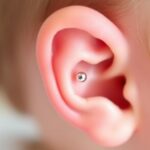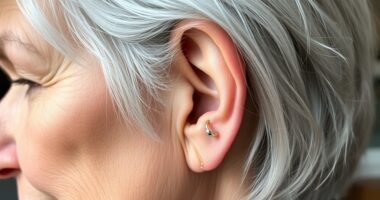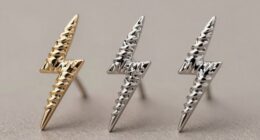Deciding whether your child should get their ears pierced at 5 or 15 depends on cultural traditions, your family’s values, and your child’s maturity. Pediatricians suggest waiting until your child is old enough to understand hygiene and care, which reduces risks and makes the experience more positive. Factors like emotional readiness and personal preference matter too. If you want an in-depth look at these considerations and expert advice, keep exploring the details.
Key Takeaways
- Pediatricians recommend considering child’s emotional maturity and understanding hygiene before piercing at any age.
- Early piercing (around age 5) can reduce fear but requires proper aftercare and safety measures.
- Waiting until age 15 allows the teen to make an informed, autonomous decision and manage post-piercing care.
- Cultural traditions and family preferences significantly influence the optimal timing for ear piercing.
- Prioritizing safety, hygiene, and emotional readiness ensures a positive piercing experience at any age.

Deciding whether to get your child’s first ear piercing at age 5 or 15 depends on personal values, maturity levels, and cultural traditions. You might consider what your family’s customs dictate or what you believe is appropriate for your child’s emotional readiness. For many parents, cultural traditions play a significant role in this decision. In some cultures, ear piercing is a rite of passage done at a very young age, often as a way to connect with heritage and community practices. If this is part of your cultural background, you may feel compelled to follow the tradition, seeing it as an important marker of identity. Conversely, if you come from a background where ear piercing is viewed as a personal choice that should be made when the child is older, you might prefer waiting until your child can decide for themselves.
Choosing between early or teen ear piercing depends on cultural traditions and your child’s maturity and preferences.
Parental preferences also deeply influence this decision. Some parents believe that piercing a very young child spares them from the discomfort and fear associated with the procedure later in life. They might opt for early piercing, thinking it’s easier to do when the child is a baby or toddler because they won’t remember the pain or resist. Others prefer to wait until their child is older, feeling that a teenager or young adult can better understand what’s involved and make an informed choice. Waiting for the child to express their desire for earrings can help ensure they’re emotionally prepared and genuinely interested, reducing the risk of regret or discomfort later.
You should also consider your child’s temperament and maturity level. If your child is naturally curious, confident, and comfortable with new experiences, they might handle a piercing at age 5 or even earlier. But if your child tends to be anxious or easily upset, waiting until they’re older might be kinder and more respectful of their feelings. Keep in mind that some pediatricians recommend delaying ear piercing until children are old enough to care for their earrings and understand hygiene practices, helping prevent infections and complications. Additionally, understanding the importance of emotional support can help you navigate their feelings throughout the process, ensuring they feel secure and cared for.
Ultimately, this decision balances respecting cultural traditions and honoring your parental preferences. It’s about what feels right for your family and your child’s well-being. Whether you choose to pierce their ears early or wait until they’re older, it’s essential to prioritize safety, proper aftercare, and your child’s comfort. Remember, there’s no universal right or wrong; the best choice aligns with your values, your child’s personality, and what you believe will make this experience positive for everyone involved.
Frequently Asked Questions
Are There Age Restrictions for Ear Piercing Procedures?
Age restrictions for ear piercing vary based on cultural traditions and parental preferences. You can typically get your ears pierced at any age, but many places recommend waiting until your child is old enough to make an informed decision. Some parents prefer waiting until their child is older, while others choose to pierce earlier for cultural reasons. Always guarantee the procedure is done safely and by a professional to minimize risks.
What Are the Long-Term Health Risks of Early Piercing?
You might wonder about long-term health risks of early ear piercing. While risks are generally low, you should be aware of potential ear infection risks if proper hygiene isn’t maintained. Additionally, piercing cartilage too early could increase the chance of cartilage damage, which may affect ear shape or cause persistent pain. To minimize these risks, guarantee a professional piercer follows strict hygiene standards and cares for your ears properly during healing.
How Should I Care for New Piercings at Different Ages?
Did you know that over 70% of parents consider cultural factors when caring for new piercings? When caring for piercings at different ages, follow your pediatrician’s guidance and respect cultural considerations. Clean the area gently with an antiseptic, avoid unnecessary touching, and monitor for signs of infection. Parental guidance is essential, especially for younger children, to guarantee proper healing and minimize complications.
Do Different Piercers Use Different Sterilization Methods?
You might wonder if different piercers use varying sterilization methods. Reputable piercers adhere to strict sterilization standards, often using autoclaves to sanitize tools thoroughly. Their certifications ensure they follow proper procedures, reducing infection risks. Always choose a licensed professional who clearly demonstrates compliance with sterilization standards. This way, you can trust that your piercing is performed safely, with all equipment properly sterilized, regardless of where you go.
Is There a Recommended Age to Delay Piercing for Safety Reasons?
Think of piercing age as planting a seed—you want it to grow safely. While many suggest waiting until your child is older, cultural considerations and parental preferences shape your choice. Pediatricians recommend delaying piercing until your child can give informed consent, typically around age 10-15, to guarantee safety. Ultimately, balancing safety with cultural values helps you decide the best time, like choosing the right moment for a delicate bloom.
Conclusion
Ultimately, the decision is yours, and there’s no one-size-fits-all answer. Whether you choose to pierce your child’s ears at 5 or wait until 15, trust your instincts and consider your child’s comfort. Remember, patience is a virtue—sometimes, waiting pays off in the long run. Whatever you decide, prioritize safety and make it a positive experience. After all, good things come to those who wait, and your child’s well-being is worth it.
















